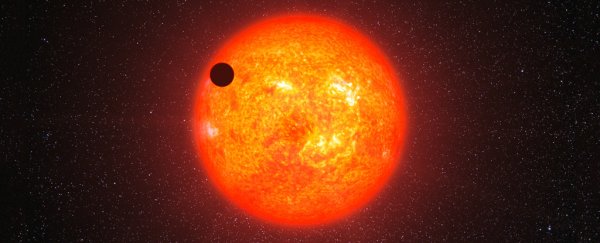Astronomers have found a telltale sign that something is tugging at the movements of Barnard's star - so it looks like we could soon be adding a planetary neighbour to the local directory of our corner of the Milky Way.
Barnard's star is a red dwarf that was already hanging out in space before our Solar System was even born. At almost 6 light-years away, it is the closest solitary star to our Sun - only the three stars in the Alpha Centauri system are closer.
Red dwarf stars are much smaller and cooler than our Sun and can have volatile magnetic activity, from dimming starspots to blazing solar flares, but Barnard's star is one of the quietest red dwarfs known.
Its relatively mild stellar weather and its proximity to us made Barnard's star seem like the perfect place to find exoplanets.
Except, for a long time, a clear sign of the existence of such a planet remained elusive - despite researchers throwing multiple detection techniques at it. There were tantalising hints though, suggesting a "wobble" in the star's movement.
"It was not a 'eureka' moment," astrophysicist Ignasi Ribas from the Institute of Space Sciences in Spain told ScienceAlert.
"Back in 2015 we were already seeing a signal arise from the data using archival observations from various facilities. But the statistical significance was low."
After observing the star more intensively to narrow the nature of the signal, the large team of researchers from around the world eventually got more confident about what they were seeing.
They analysed two decades of radial-velocity measurements from seven different spectrometers, carefully ruling out statistical flukes or interference from the instruments.
"We are quite certain that the periodic wobble of the star with an amplitude of 1.2 metres per second and 233-day period is there," Ribas explained.
"However, there are stellar phenomena that could be responsible for similar kind of signals."
To rule out other stellar phenomena, the team exhaustively ran simulations to test how likely alternate explanations might be. They estimated that the chance of the 233-day signal being due to starspot activity was less than 0.8 percent.
"After all the tests, the signal survived both in its significance and nature and we therefore concluded that the most likely explanation is the result of Keplerian reflex motion caused by a planet. Well, we are, at least, 99.2 percent sure…" Ribas told us.
The potential Super-Earth - a planet with a mass larger than Earth but smaller than ice giants like Uranus - was detected close to the 'snow-line' of Barnard's star. This is the closest distance to a star that planetary ingredients like water and other gases are able to clump together into a potential baby planet, and also near where most of these ingredients would be found.
However, details of this potential body are still very much a mystery: "We know very little about the properties of the planet," Ribas explained.
"Its mass is likely to be around 4 Earth masses and therefore it could be a rocky planet or perhaps a puffier mini-Neptune. In any case, it is almost certainly a frozen world because its equilibrium temperature is about -170 degrees Celsius."
That doesn't sound at all life-as-we-know-it friendly, but after this initial discovery, there could be potential to find planets around Barnard's star that are more Earth-like.
Excitingly, the next generation of observatory instruments due to start work during the 2020s should be able to take direct pictures and light spectrum measurements from Earth of relatively close planets like those around Barnard's star. This will help us learn much more about these exoplanets.
Ribas and his colleagues will continue collecting data on Barnard's star's movements to keep increasing their ability to detect other types of planets that might be orbiting around the red dwarf.
This study has been published in Nature.
